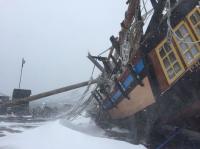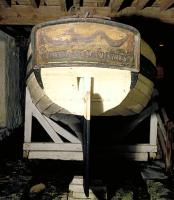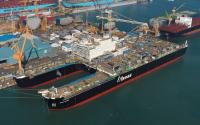 Edward Heerema, the president of Swiss-based Allseas Group S.A., had decided to name their newest and largest ship, Pieter Schelte, after his father, Pieter Schelte Heerema, who was an accomplished marine engineer. Unfortunately, that is not the only thing that his father is remembered for. During World War II, Pieter Schelte Heerema served as a Dutch officer in the Nazi Waffen SS. The naming of the ship after a Nazi officer was controversial from the day it was announced. Allseas essentially ignored the protests from Jewish groups and from the shipping labor unions. When Royal Dutch Shell, which has hired the ship to decommission offshore rigs, complained, however, Allseas payed attention. The ship has been re-named the Pioneering Spirit.
Edward Heerema, the president of Swiss-based Allseas Group S.A., had decided to name their newest and largest ship, Pieter Schelte, after his father, Pieter Schelte Heerema, who was an accomplished marine engineer. Unfortunately, that is not the only thing that his father is remembered for. During World War II, Pieter Schelte Heerema served as a Dutch officer in the Nazi Waffen SS. The naming of the ship after a Nazi officer was controversial from the day it was announced. Allseas essentially ignored the protests from Jewish groups and from the shipping labor unions. When Royal Dutch Shell, which has hired the ship to decommission offshore rigs, complained, however, Allseas payed attention. The ship has been re-named the Pioneering Spirit.
All of the controversy surrounding the name of the ship has distracted from the appreciation of size of the new ship, which may be the largest ship ever built, with a gross tonnage of 403,342 GT, a breadth of 123.75 m/406 ft and a full load displacement of 900,000 metric tons. The ship is a dynamically positioned catamaran designed to install or decommission offshore platforms and to lay pipe. Shell’s Prelude floating liquefied natural gas platform is longer but far narrower than the Pioneering Spirit and has a displacement of around 600,000 metric tonnes.

 In 1799, Eleanor Reid was only 21 and newly married to Captain Hugh Reid, commander of the Honorable East India Company extra ship Friendship. It was her husband’s first command and he was under orders to carry a cargo of Irish convicts, the result of an Irish uprising the year before, to New South Wales. French privateers prowled the seas. The East Indies charts were rudimentary, at best, not to mention all the other perils of the sea. Nevertheless, Eleanor would join her husband on the voyage. Not only was Eleanor rather fearless, but she was also a keen observer of the life aboard ship and of the cultures of the myriad islands and ports on a voyage that will continue beyond New South Wales, through the East Indies archipelago and on to India.
In 1799, Eleanor Reid was only 21 and newly married to Captain Hugh Reid, commander of the Honorable East India Company extra ship Friendship. It was her husband’s first command and he was under orders to carry a cargo of Irish convicts, the result of an Irish uprising the year before, to New South Wales. French privateers prowled the seas. The East Indies charts were rudimentary, at best, not to mention all the other perils of the sea. Nevertheless, Eleanor would join her husband on the voyage. Not only was Eleanor rather fearless, but she was also a keen observer of the life aboard ship and of the cultures of the myriad islands and ports on a voyage that will continue beyond New South Wales, through the East Indies archipelago and on to India. After a 19 month trial,
After a 19 month trial, 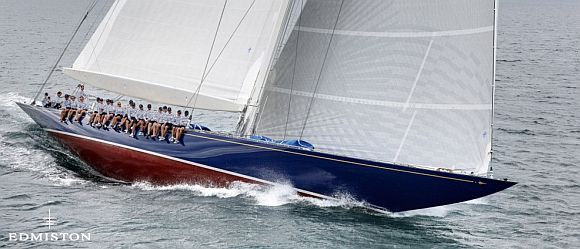 I recently saw an ad titled, “
I recently saw an ad titled, “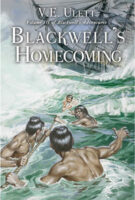 Award winning author
Award winning author 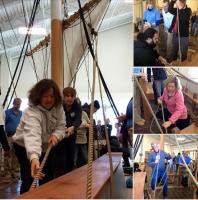 In January, we posted about
In January, we posted about 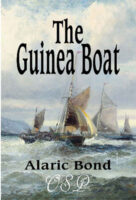 Alaric Bond’s latest novel,
Alaric Bond’s latest novel,  Terribly sad news. Captain Virginia A. Wagner passed away on Friday January 30, 2015 in Newport, Rhode Island, following a courageous battle with mesothelioma cancer. From
Terribly sad news. Captain Virginia A. Wagner passed away on Friday January 30, 2015 in Newport, Rhode Island, following a courageous battle with mesothelioma cancer. From 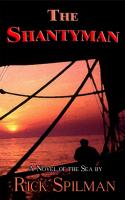 My new novel,
My new novel,  David Hayes reviews Antoine Vanner’s
David Hayes reviews Antoine Vanner’s 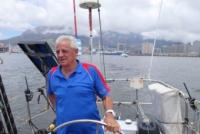
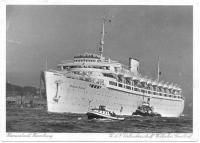 Seventy years ago today, on January 30, 1945, the German passenger liner
Seventy years ago today, on January 30, 1945, the German passenger liner 
